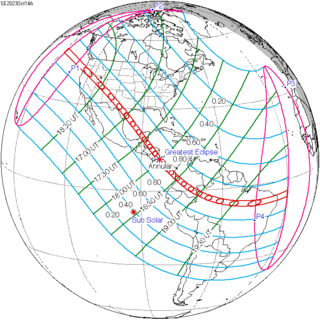| Solar eclipse of October 14, 2023 | |
|---|---|
 Annular Solar Eclipse as viewed within 170 meters (560 feet) of the eclipse centerline and within 1 second of maximum eclipse (Hobbs, New Mexico, USA). | |
| Type of eclipse | |
| Nature | Annular |
| Gamma | 0.3753 |
| Magnitude | 0.952 |
| Maximum eclipse | |
| Duration | 317 s (5 min 17 s) |
| Coordinates | 11°24′N 83°06′W / 11.4°N 83.1°W |
| Max. width of band | 187 km (116 mi) |
| Times (UTC) | |
| Greatest eclipse | 18:00:41 |
| References | |
| Saros | 134 (44 of 71) |
| Catalog # (SE5000) | 9560 |
An annular solar eclipse occurred at the Moon’s descending node of orbit on Saturday, October 14, 2023,[1][2][3][4][5][6] with a magnitude of 0.952. A solar eclipse occurs when the Moon passes between Earth and the Sun, thereby totally or partly obscuring the image of the Sun for a viewer on Earth. An annular solar eclipse occurs when the Moon's apparent diameter is smaller than the Sun's, blocking most of the Sun's light and causing the Sun to look like an annulus (ring). An annular eclipse appears as a partial eclipse over a region of the Earth thousands of kilometres wide. Occurring about 4.6 days after apogee (on October 10, 2023, at 4:40 UTC), the Moon's apparent diameter was smaller.[7]
Annularity was visible from parts of Oregon, California, Nevada, extreme southwestern Idaho, Utah, Arizona, Colorado, New Mexico, and Texas in the United States, the Yucatán Peninsula, Belize, Honduras, Nicaragua, eastern coastal Costa Rica, Panama, Colombia, and Brazil. A partial eclipse was visible for most of North America, Central America, the Caribbean, and South America.
- ^ "October 14, 2023 Annular Solar Eclipse". timeanddate. Retrieved 13 August 2024.
- ^ Cite error: The named reference
spacewas invoked but never defined (see the help page). - ^ Cite error: The named reference
nprwas invoked but never defined (see the help page). - ^ Cite error: The named reference
nytwas invoked but never defined (see the help page). - ^ Cite error: The named reference
pbswas invoked but never defined (see the help page). - ^ Cite error: The named reference
cbswas invoked but never defined (see the help page). - ^ "Moon Distances for London, United Kingdom, England". timeanddate. Retrieved 13 August 2024.
